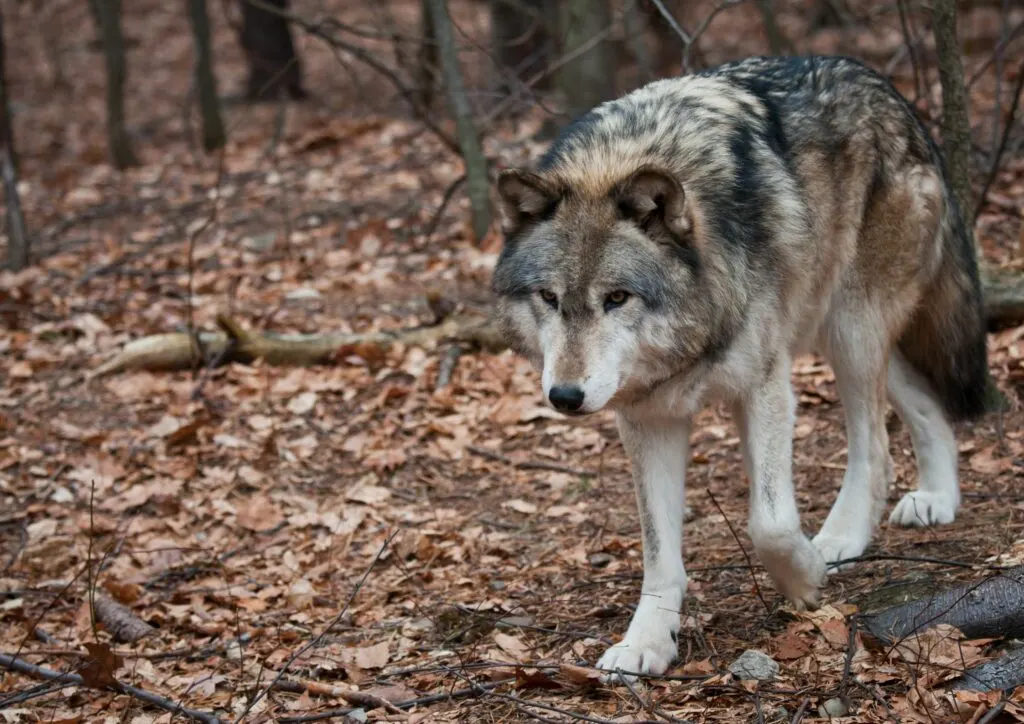Present-day wolf sightings are very rare in Colorado; the situation of these wild beasts in this state is a little more complex than what meets the eye – or so we found it to be during our exploration.
Wolves are in general fascinating to a lot of people. Their predatorial nature, hunting intelligence, sharp looks, and bone-shivering howls continue to inspire some of the most legendary myths to superstitions, and even spiritual tales.
They are one of nature’s most intimidating yet alluring creations. Travelling in packs and ruling the cold wilderness, they have earned a top place in the food chain along with other magnificently ferocious apex predators.
Wolves in Colorado – The Back Story
Colorado was once considered to have belonged to the wild wolf’s indigenous habitat. Gray wolves thrived in the lands of Colorado during the 1800s. With big game like bison, elk and deer roaming the lands, these wolf packs had plenty of nourishment.
This changed in the 1940s. When humans began to populate the nearby regions, food became scarce for the wolves. It led them to steal livestock from neighbouring communities to survive.
In response, ranchers began hunting wolves and nearly wiping them into extinction in the lands of Colorado. By the 1970s, wolves were listed under the Endangered Species Act.
A wolf reintroduction program was later introduced, which kicked off by reintroducing wolves to Yellowstone National Park. Again, this program wasn’t perfect as it had its cons like the livestock going missing.
More steps were taken as recently as 2020 to strengthen this Wolf Reintroduction Program and wildlife officials are working towards reintroducing gray wolves to the Western slope by 2023.
Gray Wolves 101

Gray wolves (Canis Lupus) are native to Colorado. Their fur colour can range from gray (shocker), to black and even white.
These beauties can be big. When it came to height, some looked like they were slightly higher than our waistline, but in general, they usually have an 80 – 85 cm height and weigh about 80 kg.
Strong muscles, thick fur and super sharp eyes – these features alone can induce some serious levels of intimidation.
You might be interested in: Can you eat Wolf in Alaska?
Diet – Time to Wolf Down!
Gray wolves are known to hunt and eat big mammals like moose, elk even deer. They sometimes tend to prey on smaller animals like rabbits – depending on how hungry they are, and who is in the hunting perimeter.
Behaviour – Release the Inner Wolf
Wolves – Gray wolves especially, travel and hunt in packs of 7 – 8. They are known to build strong relationships with their packs – a demonstration of true teamwork.
Wolves also have a rather complex means of communication with each other, where each animal has its own unique howl; this was evident to us during our wolf sightings with howls ranging from throaty to more goosebumps-inducing ones! It was truly an otherworldly experience.
We also got to know that wolves talk to each other through barks and growls. We learned (sadly) that howling at the moon is not a thing. In fact, wolves become more active during dawn and dusk.
Fun fact: Wolves can run up to 64 kilometres per hour (in short bursts)
Wolf Breeding
A pack usually consists of a mom and dad – also known as the alpha male and female, and a couple of pups. The mating season falls between January and February.
It’s usually the coldest months of the year, so it’s fascinating that they chose this time to mate.
Where to See Wolves in Colorado
Like us, if you are the type of traveller who feels blessed to have the opportunity to see majestic predators like wolves up close and personal, then there are some places in Colorado where you could witness them up close without endangering yourself.
Below are some of the recommended places:
Colorado Wolf and Wildlife Center
This Wildlife Centre is a 2-hour drive from the city of Denver. As you drive through Twin Rocks road, you get to enjoy the stunning woodlands on either side, it sets you in the mood for what you’ll soon get to experience.
Avoid visiting on Mondays because they are closed.
The Wildlife Centre looks spacious right from the get-go. In order to make a reservation you have to call ahead and make the booking online. They offer various tours, the standard tour is more readily available, unlike the Full Moon tours – which are only available once a month on a Saturday – during the Full Moon (obviously).
Peak season usually falls from May to October, and the Wildlife centre is open all year round. Tickets per person are 25 USD, and for children aged below 12, it’s 15 USD per head. The standard tour takes approx.1 hour, the guides are enthusiastic, and they have a lot of super cool information.
You even have the chance to get up close to the wolves. However, you know right away that you are in the presence of an apex predator. These tours can be very memorable.
If that is not enough, you can even opt for a Meet and Greet encounter where the guides allow a party of 16 to enter a closed enclosure where you can get up close and personal with the most guest-friendly wolves.
If you want to enjoy the same incredible experience all by yourself instead of with a group, you can even opt for a VIP encounter – which can cost around 450 USD (for two guests).
Did we mention each tour ends with a group howl? It’s super cool.
The Wild Animal Sanctuary
This sanctuary is located in Keenesburg, Colorado – just an hour away from Denver City.
It’s 700 acres of spacious grasslands. It’s open all year round – except on Independence Day, Thanksgiving, Christmas, and New Year’s Day. Here you have the opportunity to meet other wildlife predators apart from Gray Wolves like African Lions, Coyotes, Black bears and Bobcats.
You can spend quite a bit of time here, maybe even have a picnic after your tour. It can get breezy, but if it’s summertime, then as you get close to mid-day, the heat turns up, so bring your hats, your sunscreen and most importantly your water.
Keep in mind that this is nothing like a Zoo but a sanctuary for wildlife with a great deal of expert care. A majority of visitors always have a lot of good things to say about this place.
Frequently Asked Questions
Were the wolves that were introduced to Yellowstone National Park native to the US?
The wolves chosen for this introductory project were said to be biologically closest to the wolf species that historically inhabited the region. The translocation helped boost the wolf population.
Do wolves tend to steal livestock?
While there are records of wolves killing livestock – this is not something that has gotten out of control. According to the records of the USDA – out of 100 million cows raised in the US only, 200,000 are lost due to predatory attacks.
Are wolves a threat to human safety?
In the last 150 years, incidents of wolf attacks on humans have been just a handful, and the fatality of the attacks is even less.

